Aila, Polynesian or Tahitian chestnut
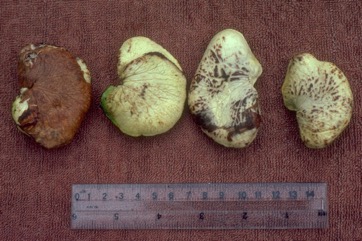
A tropical plant. It grows in the lowland primary and secondary forest from sea level up to 390 m altitude. It often grows near rivers and swamps and mostly as a clump of trees. Often they are very close to the water front. It also occurs in the Pacific Islands. It is usually in areas with a rainfall between 1500-4300 mm a year. They do better where there is no distinct dry season. It grows in soils with a pH from 5-14. It can grow in very alkaline soils. It can grow in salty and infertile soils.
Also known as:
Ailali, Arau, Bloy, Bl'oy, Booi, Bui, Buoy, Dola, Dulafa, Gajam, Gatet, Gayam, Gnuilaba, I'i, Ifi, Ihi, Isi, Ivi, Ivi damu, Ivi sere, Julapa, Kayam, Keam, Kihrak, Kurak, Maba, Mabe, Mabwe, Mamba, Mamboa, Mambwe, Mape, Marap, Marare, Marau, Mop, Mwaqe, Mwerepw, Mworopw, Mwuropw, Namambe, Naqi, Nokomo, Nyia oki, Otaheite chestnut, Paravu, Paravua, Pohon gayam, Rata, Te ibi, Te karaka, Tolok, Zulapa
Synonyms
- Inocarpus fagiferus (Park.) Fosb.
- Aniotum edulis Forster
- Aniotum fagiferum Parkinson
- Bocoa edulis (J. R. Forst. & G. Forst.) Baill.
- Inocarpus edulis J. R. Forst. & G. Forst.
Edible Portion
- Seeds, Leaves, Nut, Fruit
Where does Aila grow?
Found in: American Samoa, Asia, Australia, Bougainville, Caroline Islands, Christmas Island, Chuuk, Cook Islands, East Timor, Fiji, FSM, Guam, Hawaii, Indonesia, Kiribati, Kosrae, Malaysia, Mariana Islands, Marquesas, Marshall Islands, Micronesia, New Caledonia, New Zealand, Pacific, Palau, Papua New Guinea, PNG, Philippines, Pohnpei, Rotuma, Samoa, SE Asia, Singapore, Society Islands, Solomon Islands, Suriname, Tonga, French Polynesia - Austral Islands, Timor-Leste, Truk, United States, Vanuatu, Wallis and Futuna, Yap
Notes: There are 3 Inocarpus species. Aila Inocarpus fagifer What is an Aila tree like? An Aila or Tahitian chestnut is a large tree 20 metres or more tall and with buttresses at the base of the trunk. The bark is dark grey and gives a red sap when cut. The branches droop downwards. The leaves are long (20 cm), leathery, shiny and feather veined. The leaves have short stalks and are one after the other (alternate) along the branch. Young leaves are pink. The flowers of Aila are not obvious. They are pale yellow and hang loosely on the twigs from the angles where leaves join. They have 5 narrow petals joined in a tube. The flowers smell sweetly. The fruit is irregular or kidney shaped and has one seed inside. The outside of the pod is thick and leathery with a lumpy surface. It can be 8-10 cm across and 3 cm thick. The ripe fruit is yellow. The fleshy layer around the seed is eaten. Where do Aila nut trees grow? Aila nut trees grow near sea level. Often they are very close to the water front. They are common on some of the off shore islands. They can grow in swampy ground and are common in some river estuaries. Trees can probably grow from sea level up to about 300m altitude. They do better where there is no distinct dry season. Aila nut trees do not only occur in Papua New Guinea but occur in some other South East Asian and Pacific countries as well. The map shows places where the trees occur naturally or commonly. The countries include Malaysia, Indonesia and Pacific islands such as Fiji, Tahiti and Samoa as well as Papua New Guinea. Growing Aila nuts. Aila nut trees often grow self sown. The fruits are distributed by bats and other animals, although the seeds float easily as well. Trees can be grown from seed. Trees can commence producing fruit about 8 years after planting. It is also possible to grow trees from cuttings. Aila nuts are produced seasonally. The season is about the beginning of the year probably from January to May. Ails nuts as food. The nuts are usually roasted although they can be boiled. Soaked nuts can be grated, mixed with coconut milk and roasted in banana leaves. Seeds can be stored by partly fermenting them in pits in the ground. Nuts can be stored for a considerable time but once shelled or cooked will only keep a short time. The wood of the tree is good for firewood.
Status: They occur in most coastal areas of Papua New Guinea, normally very close to the coast. Fruit are sold in markets.
Growing Aila, Polynesian or Tahitian chestnut
Cultivation: Seeds are mostly planted. Seeds are also naturally distributed by bats. Plants can be propagated vegetatively by cuttings of half ripe wood. Seeds are the more common method of production. Seeds store easily for over a month but viability declines fairly rapidly in salt water. Trees prefer swampy ground but they also grow satisfactorily on higher slopes. It is presumed that plants have some salt tolerance as they often grow along the foreshore. A spacing of 5-10 m is probably suitable.
Edible Uses: Seeds are cooked and eaten. The fleshy layer around the seed is eaten after cooking. The nuts are usually roasted although they can be boiled. Soaked nuts can be grated, mixed with coconut milk and roasted in banana leaves. Seeds can be stored by partly fermenting them in pits in the ground. Nuts can be stored for a considerable time but once shelled or cooked will only keep a short time.
Production: It grows moderately quickly. It can grow 2 m per year. Time to first production of nuts from planting is about 8 years. An average seed weighs 40 g. The yield can be 75 kg of fruit per tree per year. Fruit production occurs throughout the year but has a main season. Uncooked seeds can be stored.
Nutrition Info
per 100g edible portion| Edible Part | Energy (kcal) | Protein (g) | Iron (mg) | Vitamin A (ug) | Vitamin c (mg) | Zinc (mg) | % Water |
|---|---|---|---|---|---|---|---|
| Nuts | 241 | 4.5 | 3 | 0 | 2 | 1.3 | 43 |
Aila, Polynesian or Tahitian chestnut Photos

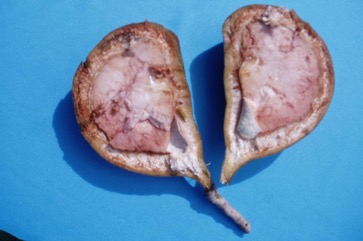
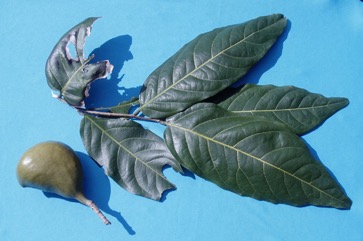
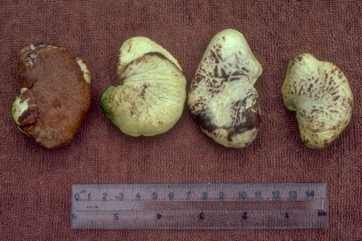
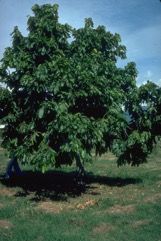
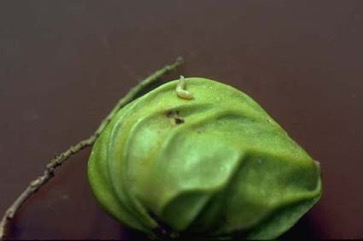
References
Aila references
Adlung, , 1918, Tropenpflanzer 21, p 196
Arora, R. K., 2014, Diversity in Underutilized Plant Species - An Asia-Pacific Perspective. Bioversity International. p 94
Backer, C.A., 1911, Schoolflora voor Java
Backer, C.A., & Bakhuizen, R.C., v.d. Brink, 1964, Flora of Java 1, 619
Bailey, F.M., 1909, Inocarpus in Queensland Ag. J. Mar 1909, p147
Bailey, F.M., 1910, Inocarpus in Queensland Ag. J. Jan. 1910, p 21
Balgooy, M.M.J. van, 1975, Inocarpus in Pacific Plant Areas. p 370-371.
Barrau, J., 1976, Subsistence Agriculture in Melanesia. Bernice P. Bishop Museu, Bulletin 219 Honolulu Hawaii. Kraus reprint. p 53 (As Inocarpus edulis)
Barrau, J., 1976, Subsistence Agriculture in Polynesia and Micronesia. Bernice P. Bishop Museu, Bulletin 223 Honolulu Hawaii. Kraus reprint. p 53 (As Inocarpus edulis)
Barrau, J., 1961, Inocarpus edulis in Agriculture in Polynesia and Micronesia p 55
Batet, K., Koil, U., and Hertel, H., 1998, Traditional Plant Use by the Didipa Clan, Baitabag, Papua New Guinea. GDS. p 29
Bodkin, F., 1991, Encyclopedia Botanica. Cornstalk publishing, p 582
Borrell, O.W., 1989, An Annotated Checklist of the Flora of Kairiru Island, New Guinea. Marcellin College, Victoria Australia. p 91, 194
Bourke, R. M., Altitudinal limits of 230 economic crop species in Papua New Guinea. Terra australis 32.
Bourke, M., 1995, Edible Indigenous Nuts in Papua New Guinea. In South Pacific Indigenous Nuts. ACIAR Proceedings No 69, Canberra. p 46
Bradacs, G., 2008, Ethnobotanical Survey and Biological Screening of Medicinal Plants from Vanuatu. PhD thesis Frankurt University. p 101
Brown, F.B.H., 1933, Flora of South Eastern Polynesia 3. Dicotyledons. Bishop Museum Bulletin 130 p 118
Brown, ,19 , Inocarpus edulis in Useful Plants of the Philippines. p122,123.
Burkill, I.H., 1935, Inocarpus in A Dictionary of the Economic Plants of the Malay Peninsula. p 1260 (As Inocarpus edulis)
Cabalion, P. and Morat, P., 1983, Introduction le vegetation, la flore et aux noms vernaculaires de l'ile de Pentcoste (Vanuatu), In: Journal d'agriculture traditionnelle et de botanique appliquee JATBA Vol. 30, 3-4 (As Inocarpus edulis)
Christopherson, E., 1935, Flowering Plants of Samoa. Bishop Museum Bulletin No 128. p 102.
Clarke, W.C. & Thaman, R.R., 1993, Agroforestry in the Pacific Islands: Systems for sustainability. United Nations University Press. New York. p 79, 243
Corner, E.J.H., 1952, Wayside Trees of Malaysia. 1 ed 2 p 395
Coronel, R.E., 1982, Fruit Collections in the Philippines. IBPGR Newsletter p 7 (As Inocarpus edulis)
Cowie, I, 2006, A Survey of Flora and vegetation of the proposed Jaco-Tutuala-Lore National Park. Timor-Lests (East Timor) www.territorystories.nt/gov.au p 47
Darley, J.J., 1993, Know and Enjoy Tropical Fruit. P & S Publishers. p 78 (As Inocarpus edulis)
Elevitch, C.R.(ed.), 2006, Traditional Trees of the Pacific Islands: Their Culture, Environment and Use. Permanent Agriculture Resources, Holualoa, Hawaii. p 407
Evans, B. R, 1999, Edible nut Trees in Solomon Islands. A variety collection of Canarium, Terminalia and Barringtonia. ACIAR Technical Report No. 44 96pp
Facciola, S., 1998, Cornucopia 2: a Source Book of Edible Plants. Kampong Publications, p 106 (As Inocarpus edulis)
Flora of Solomon Islands
Fosberg, 1941, Journ Wash. Acad. Sci. 31:95
Franklin, J., Keppel, G., & Whistler, W., 2008, The vegetation and flora of Lakeba, Nayau and Aiwa Islands, Central Lau Group, Fiji. Micronesica 40(1/2): 169–225, 2008
French, B and Bridle, C., 1978, Food Crops of Papua New Guinea p 44 Vudal Agricultural College
French, B.R., 1986, Food Plants of Papua New Guinea, A Compendium. Asia Pacific Science Foundation p 180
French, B.R., 2010, Food Plants of Solomon Islands. A Compendium. Food Plants International Inc. p 193
GTZ 1996, A Guide to some Indigenous Fijian Trees. GTZ Suva. p 87
Guppy, H.B., 1906, Plant Dispersal. 421, 422.
Hartley, T.G., 1973, A Survey of New Guinea Plants for Alkaloids. Lloydia 36(3):258
Havel, J.J., 1975, Forest Botany, Volume 3 Part 2 Botanical taxonomy. Papua New Guinea Department of Forests, p 110
Hedrick, U.P. (ed), 1919, Sturtevant’s Edible Plants of the World p 313. (356)
Henderson, C. P. and I. R. Hancock, 1988, A Guide to the Useful Plants of the Solomon Islands. Res. Dept. Min of Ag. & Lands. Honiara, Solomon Islands. p 37
Johns, R.J., Common Forest Trees of PNG. p Forest College Bulolo.
J. Wash. Acad. Sci. 31:95. 1941 "fagiferus" - the spelling has been corrected to reflect the proper Latin termination (ICBN Art. 32.5) for the masculine form of this adjectival epithet (see also W. T. Stearn, Botanical Latin ed. 4:9
Kanehira, R., 1931, An enumaration of the woody plants collected in Micronesia, Japanese Mandate (in 1929 and 1930). The Botany Magazine. Vol. XLV, No. 53 p 285 (As Inocarpus edulis)
Kitalong, A. H., DeMeo, R. A., & Holm, T., 2013, A Field Guide to the Native Trees of Palau. 2nd edition. USDA p92
Kiple, K.F. & Ornelas, K.C., (eds), 2000, The Cambridge World History of Food. CUP p 1837 (As Inocarpus edulis)
Kostermans, A.J.G.H., 1950, A new Species of Inocarpus Forster. Bulletin of the Bot. Gard. Buitenzorg. Ser 3. Vol 18(4) p 446-448.
Lebot, V. & Sam, C., Green desert or ‘all you can eat’? How diverse and edible was the flora of Vanuatu before human introductions?. Terra australis 52 p 409
Leon, J., 1968, Fundamentos Botanicos de Los Cultivos Tropicales p 318
Lepofsky, D., 1992, Arboriculture in the Mussau Islands, Bismarck Archipelago. Economic Botany, Vol 46, No. 2, pp. 192-211
Liefting, A., et al, Samoan plant names. http://en.wikipedia.org
Macmillan, H.F. (Revised Barlow, H.S., et al) 1991, Tropical Planting and Gardening. Sixth edition. Malayan Nature Society. Kuala Lumpur. p 302
Maesen, L. J. G. van der and Sadikin Somaatmadja, eds. 1989. Pulses. In: E. W. M. Verheij & R. E. Coronel (eds.), Plant Resources of South-East Asia (PROSEA). (Pl Res SEAs) 1:84.
Martin, F. W., et al, 1987, Perennial Edible Fruits of the Tropics. USDA Handbook 642 p 35
Massal, E. and Barrau, J., 1973, Food Plants of the South Sea Islands. SPC Technical Paper No 94. Nounea, New Caledonia. p 30
McClatchey, W. C., 2012, Wild food plants of Remote Oceania. Acta Societatis Botanicorum Poloniae 81(4) 371-380
Menninger, E.A.,1977, Edible Nuts of the World p 95, Horticultural Books.
Merrill, E.D., 1923, Enum. Philipp. Pl. 2:292.
Merrill, 1954, Inocarpus edulis Chron. Bot. 14:347
Moll and Jansonnius, 1914, Mikrogr, d. Holzes Java, 3
Parham, H. B. R, 1940, Supplement to the Journal of the Polynesian Society No. 16. Fiji Plants: Their Name and Uses.
Peekel, P. G., (Transl. 1984 by Henty, E), Inocarpus in Flora of the Bismarck Archipelago. Division of Botany, Lae. p 245.
Pijl, : v.d., 1957, Acta Bot. Neerdl. 6:291-315
PROSEA
Ridley, H.N., 1930, Dispersal. 281, 282, 348, 374, 529.
Rosengarten, F., The book of edible nuts. 1984
Safford,W.E.,1905, Useful Plants of Guam. Contr.U.S.Nat.Herb.
Seeman, B., 1873, Fl. Viti. 70, 71
Smith, A.C., 1985, Flora Vitiensis Nova, Lawaii, Kuai, Hawaii, Volume 3 p 159
Sotheeswaran, S., and Sharif, M. R. et al, 1994, Lipids from the seeds of seven Fijian plant species. Food Chemistry. 49:11-13
St John, H., 1972, Biol. J. Linn. Soc., 4:305-310.
Sukarya, D. G., (Ed.) 2013, 3,500 Plant Species of the Botanic Gardens of Indonesia. LIPI p 337
Sukenti, K., et al, 2016, Ethnobotanical study on local cuisine of the Sasak tribe in Lombok Island, Indonesia. Journal of Ethnic Foods. 3 (2016) 189-200 p 198
Terrell et al. 1986. Agric. Handb. no. 505.
Thaman, R.R., 1976, The Tongan Agricultural System, University of the South Pacific, Suva, Fiji. p 405
Thaman, R. R., 1987, Plants of Kiribati: A listing and analysis of vernacular names. Atoll Research Bulletin No. 296
USDA, ARS, National Genetic Resources Program. Germplasm Resources Information Network - (GRIN). [Online Database] National Germplasm Resources Laboratory, Beltsville, Maryland. Available: www.ars-grin.gov/cgi-bin/npgs/html/econ.pl (10 April 2000)
Verdcourt, B., 1979, Inocarpus fagifer in Manual of New Guinea Legumes. Botany Bulletin No 11, Division of Botany, Lae, Papua New Guinea. p 302
Versteegh,C., 1971, Key to the most important native trees of Irian Barat(Indonesia) Based on Field Characters p 21 Med.Landb.Wag. Warburg, , Bot.Jahrb.
Walter, A & Sam, C., 1995, Indigenous Nut Trees in Vanuatu: Ethnobotany and Variability. In South Pacific Indigenous Nuts. ACIAR Proceedings No 69. Canberra. p 57
Walter, A. & Sam C., 2002, Fruits of Oceania. ACIAR Monograph No. 85. Canberra. p 183
Wester, P.J., 1925, The Food Plants of the Philippines. Bureau of Ag. Bull. 39 p 122
Whistler, W.A., 2004, Rainforest Trees of Samoa. Isle Botanica Honolulu, Hawaii. p 71
Whitm., ed. 1972-. Tree flora of Malaya.
Wickens, G.E., 1995, Edible Nuts. FAO Non-wood forest products. FAO, Rome. p 142
World Checklist of Useful Plant Species 2020. Royal Botanic Gardens, Kew
Yen, D.E., 1974, Arboriculture in the Subsistence of Santa Cruz, Solomon Islands. Econ. Bot. 28:252, 261.
Yuncker, T.G., 1959, Plants of Tonga, Bernice P. Bishop Museum, Hawaii, Bulletin 220. p 143